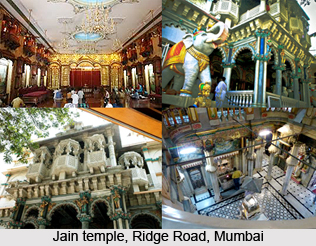 Jain Temple located on Ridge Road (B C Kher Marg), on Malabar Hill, Downtown and is one of the most notable of the Jain temples in Mumbai. This Jain temple was built for the use of the Swetambar Jains, constructed in 1904. The marble monument has a constant flow of devotees moving in and out, catching the eye of everybody, due to its ambience of peace and serenity.
Jain Temple located on Ridge Road (B C Kher Marg), on Malabar Hill, Downtown and is one of the most notable of the Jain temples in Mumbai. This Jain temple was built for the use of the Swetambar Jains, constructed in 1904. The marble monument has a constant flow of devotees moving in and out, catching the eye of everybody, due to its ambience of peace and serenity.
The temple is officially called Babu Amichand Panalal Adishwarji Jain Temple. The Shrine is dedicated to Adinath, the first Tirthankara or apostle. The walls of the temple are adorned with beautiful paintings depicting the various incidents in the lives of the 24 Tirthankaras of the Jain religion. Two stone elephants flank the entrance. On its first floor, there is a special shrine dedicated to Parsvanath, carved out of black marble, the ceiling showcasing the different planets as personified in Hindu mythology. The downstairs area, houses an array of deities and saints, including an image of Ganesha, which recalls historical amalgamation between Jainism and Hinduism.
The Jains are known to be exceptionally adept in the world of business, and they believe in self-restraint and aestheticism, due to which the Jain temple is highly well maintained, as they pour huge sums of money, for their holy place of worship. The significant information here is that, the Jains never offer flowers to the God/Goddess in their temples, because they strictly believe in not killing any insects that might be present in the offerings.
In order to get there, one needs to hire a taxi from Charni Road Station West Mumbai, or either from Grant Road Station West, which takes about 15 to 20 minutes to reach. One can also catch a bus for Malabar Hill. It is located a bit closer to the famous `Hanging Garden`, in Malabar Hill in Mumbai.
One can see the Hanging Garden (Kamla Nehru Park), which has a very good garden view at Walkeshwar. It is not known why it is named Hanging Garden, but it has a picturesque View Point from where one can see a beautiful girgaon/girgaum Chowpatty view. It also has a Children Playing boot/shoe House. Then the `Banganga`, the spiritual Hundu `kund` (pond) can also be seen. The very famous Chowpatty Beach is near Wilson College.





















